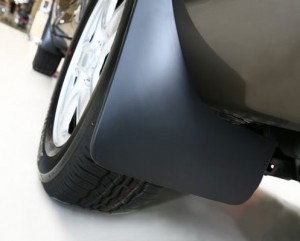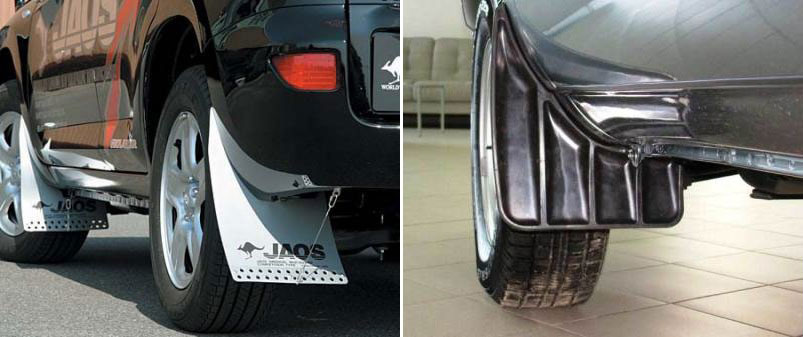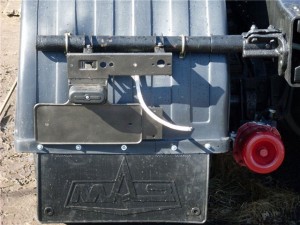
Almost every wheeled vehicle has an important part that provides protection against dirt, water and stones - wheel mudguards. Read about what a wheel mudguard is, what types it is, how it works and what functions it performs, as well as the right choice of mudguards and their installation, read the article.
What is a wheel mudguard?
Wheel mudguard - the external equipment of the vehicle; sheet parts mounted directly behind the wheels perpendicular to the road surface, designed to prevent contact of the structural elements of the car and other road users with dirt, snow, crushed stone, water and other objects flying out from under the wheels.
The movement of wheeled motor vehicles is based on the transfer of torque from the wheel to the road surface, as a result of which frictional forces are overcome and, in accordance with the laws of mechanics, the car receives momentum and is set in motion. However, the moment is transmitted both to the road and to everything that is on it - dust, stones, snow, water, etc. All these bodies receive acceleration tangentially to the circumference of the wheel - this leads to their ejection from under the wheels. Therefore, any wheeled vehicle needs special protection against these problems - wheel mudguards act as such protection.
Mudguards have the following key functions:
● Practical - protection against stones, dirt, snow and water flying out from under the wheels;
● Aesthetic - improving the exterior of the car and its aesthetics as a whole.
Mudguards are important parts of vehicles, in certain cases their absence can even cause a fine, so if this part breaks down or is lost, it should be replaced as soon as possible. And, in order to make the right choice, it is necessary to understand in more detail the types, designs and features of modern mudguards.
Classification, design and applicability of mudguards
Mudguards can be divided into several types according to the place of installation, purpose, applicability, material of manufacture and design features.
According to the place of installation, the parts in question are divided into two types:
● For front axle wheels;
● For rear axle wheels.
At the same time, all mudguards are divided into two groups according to their main purpose:
● To protect the space located behind the rear of the wheels - in fact, mudguards;
● To protect the space and objects located in front of the wheels, these can be full-fledged front mudguards or short mudguards, which are a continuation of the fender liner (dirt-proof apron).
According to the applicability, mudguards can be divided into groups according to the following criteria:
● Original and universal - the former are suitable for a specific model range or even a separate car model, the latter can be used on various vehicles with fenders and wheel arches that are suitable in size and configuration;
● Protective and for tuning - the first are installed on the car to provide protection, the second are mounted to decorate the vehicle (although decorative elements provide a certain degree of protection against dirt);
● Cars and trucks - the former are small in size and have a special shape to improve aerodynamic qualities, the latter are enlarged and made in the form of a straight sheet.
According to the material of manufacture, mudguards are divided into three groups:
● Rubber;
● Plastic;
● Rubber-plastic.
Rubber mudguards are made of rubber using various technologies, they are elastic, well resist shocks and negative environmental factors, inexpensive and easy to operate. However, they have a number of drawbacks: low strength and resistance to objects with pointed edges (they can tear under the blows of stones). In addition, rubber mudguards can deviate excessively under the influence of the oncoming flow of air and water, as a result of which their degree of protection is significantly reduced. To eliminate this drawback, large-area mudguards (cargo) can be equipped with metal weighting pads.

Mudguards for passenger cars
Rubber mudguards are made of rubber using various technologies, they are elastic, well resist shocks and negative environmental factors, inexpensive and easy to operate. However, they have a number of drawbacks: low strength and resistance to objects with pointed edges (they can tear under the blows of stones). In addition, rubber mudguards can deviate excessively under the influence of the oncoming flow of air and water, as a result of which their degree of protection is significantly reduced. To eliminate this drawback, large-area mudguards (cargo) can be equipped with metal weighting pads.
Plastic mudguards are made of various plastics, they have high strength and sufficient rigidity, which solves the problem of their deflection under the influence of air and water flow. Plastic products can be given any shape, so they are used on cars with complex body contours. However, plastic mudguards are quite brittle, they can collapse when hitting obstacles and due to strong blows of stones, especially this problem is exacerbated in cold weather, as plastic becomes brittle at low temperatures. Plastic mudguards are inexpensive, but they are gradually being replaced by more reliable rubber-plastic ones.
Rubber-plastic mudguards are made of special types of polymers that combine the properties of rubber and plastic - sufficient elasticity and resistance to impact, coupled with strength and reliability in performing their functions. Such mudguards are most often used on passenger cars, including tuning. Their higher price pays off with a long service life.
Metal mudguards, often used on trucks, can be distinguished in a separate group. These parts are an extension of the wing and are often complemented by short rubber aprons. This kind of mudguards are most often installed on the wheels of the rear axle (axles) of many new trucks of domestic and foreign production.
Mudguards of all types have essentially the same design: it is a flat sheet (on trucks) or a part of a more complex shape (on cars), on which additional parts and elements may be present:
● Aerodynamic slots or louvers - slots reduce the area of the mudguard, increasing its aerodynamic quality, while ensuring a fairly efficient performance of the basic functions of the product (especially blinds that direct water, dirt and stones down);
● Reflective devices (reflectors) and other signaling devices;
● On large-area rubber mudguards - weights in the lower part for weighting;
● Decorative inscriptions, markings, etc.

Metal mudguard with rubber apron truck
Regardless of the type, design and installation location, mudguards are mounted on the lower part of the body, frame or special brackets behind the wheel, covering from half to 4/5 or more of the height of the ground clearance. Installation is carried out on bolts, screws or self-tapping screws. Large cargo mudguards can additionally be pulled back by chains that prevent the part from entering the wheel while the vehicle is moving.
Wheel mudguards and fines
Before talking about the selection and installation of mudguards, you need to focus on the legal side of the use of these parts. As stated in clause 7.5. "List of malfunctions and conditions under which the operation of vehicles is prohibited", the operation of mechanical vehicles is prohibited in the absence of mudguards, dirt-proof aprons and other rear protective devices provided for by the design. Therefore, if mudguards are installed on the vehicle by the manufacturer, but they are absent for one reason or another, this may lead to a fine. Such vehicles include all trucks.
And vice versa: the installation of mudguards on a passenger car, on which these parts were not originally allowed, is allowed and does not entail administrative liability. This opens up great opportunities for tuning.
How to choose and replace the wheel mudguard
The choice of new wheel mudguards should be made based on the type and model of the vehicle, the purpose of the mudguards and the characteristics of their operation.
If the mudguards were installed normally, then it is best to take parts of the same type and catalog number that were on the car earlier - this will be a guarantee that the mudguards will definitely fall into place without alterations. Today, however, there is a wide variety of versatile mudguards that can be trimmed and installed if necessary without being tied to their mounting holes. Universal mudguards are easier to find, and they are inexpensive, so this can be a good solution.
If mudguards are needed for tuning, then here the car owner is offered an infinite number of options and possibilities. The main thing when choosing such mudguards is their size and the possibility of mounting on this particular vehicle. Therefore, before buying, you should at least roughly know the width of the wheel arch at the place where the mudguard is installed and the amount of ground clearance.
When buying, you need to take into account that mudguards can be sold both separately (usually parts for trucks) and complete sets (for passenger cars) with fasteners. If there are no fasteners in the kit, then you should take care of purchasing screws, screws or bolts with nuts.
Installation of mudguards should be carried out in accordance with the instructions attached to them, or instructions for repairing the car. If the work is done correctly, the mudguards will fall into place and provide the necessary degree of protection.
Post time: Jul-14-2023
